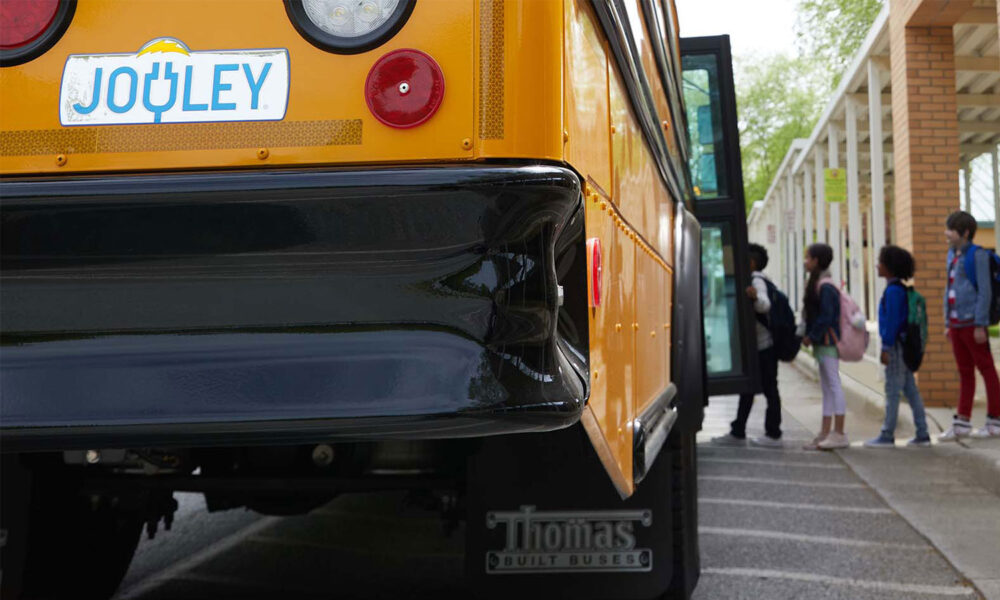The iconic yellow school bus is a familiar sight on our streets no matter where you live in the US, transporting millions of kids safely to and from school every day. While the color of school buses is still the same old yellow that it was when I was going to elementary school, there’s been a lot of changes going on under the hood recently. It turns out school buses are at the leading edge of the transition to electric heavy-duty vehicles. This is great news for our kids, our communities and our climate.
But just in case there was any doubt, UCS crunched the numbers to compare the different types of school buses from gasoline and diesel-powered option, to natural gas, electric and yes – even propane.
Here’s why electric buses are hands down the best option:
EPA’s Clean School Bus Program paves the way to cleaner buses
In the early 2000s, UCS graded school bus fleets across the country, and found that many states were failing to invest in newer buses with more modern emission controls. Diesel school buses – which represent the majority of school buses – were not only sending out toxic fumes from the tailpipe, but pollution was getting inside the buses, exposing children to unhealthy air. The Environmental Protection Agency’s (EPA) Clean School Bus (CSB) Program was established by the Energy Policy Act of 2005 to help communities reduce pollution from older, higher polluting school buses.
Despite past investments, thousands of older polluting school buses remain on the road. To supercharge the transition to clean school buses, Congress amended and reinvigorated the Clean School Bus Program with a $5 billion dollars over 5 years investment as part of the 2021 Infrastructure Investment and Jobs Act (also known as the Bipartisan Infrastructure Law). Funding released to date is supporting the replacement of about 8,500 buses in school districts all around the country.
Electric buses are the most popular choice for clean school buses
The good news is that 92% of the recent program funding has gone to supporting electric zero emission school bus purchases and charging infrastructure investments. Why not 100 percent? The infrastructure law allows for some of the funds to be used for other types of buses including natural gas or propane-powered buses. While these options were once cleaner alternatives to their diesel counterparts, they are no longer the best choice. Today, electric buses which completely eliminate tailpipe emissions, are a readily available option from school bus manufacturers.
By the numbers: electric school buses are the cleanest option
My colleague Dave Cooke recently undertook an analysis to get a clearer picture of how modern school bus options compare for their climate and public health impact. This analysis factors in the tailpipe emissions (“direct” emissions) for combustion engines like gasoline, diesel, natural gas, and propane, and also includes the upstream pollution from extracting (“feedstock” emissions) and refining these fuels (“fuel” emissions).
Similarly, for electric school buses, the pollution from generating the electricity at the power plant (shown as “fuel” emissions) and the pollution associated with the extraction and processing of fuels used in the powerplants such as natural gas or coal (“feedstock” emissions) are included. The results of this “Wells to Wheels” analysis are shown below.
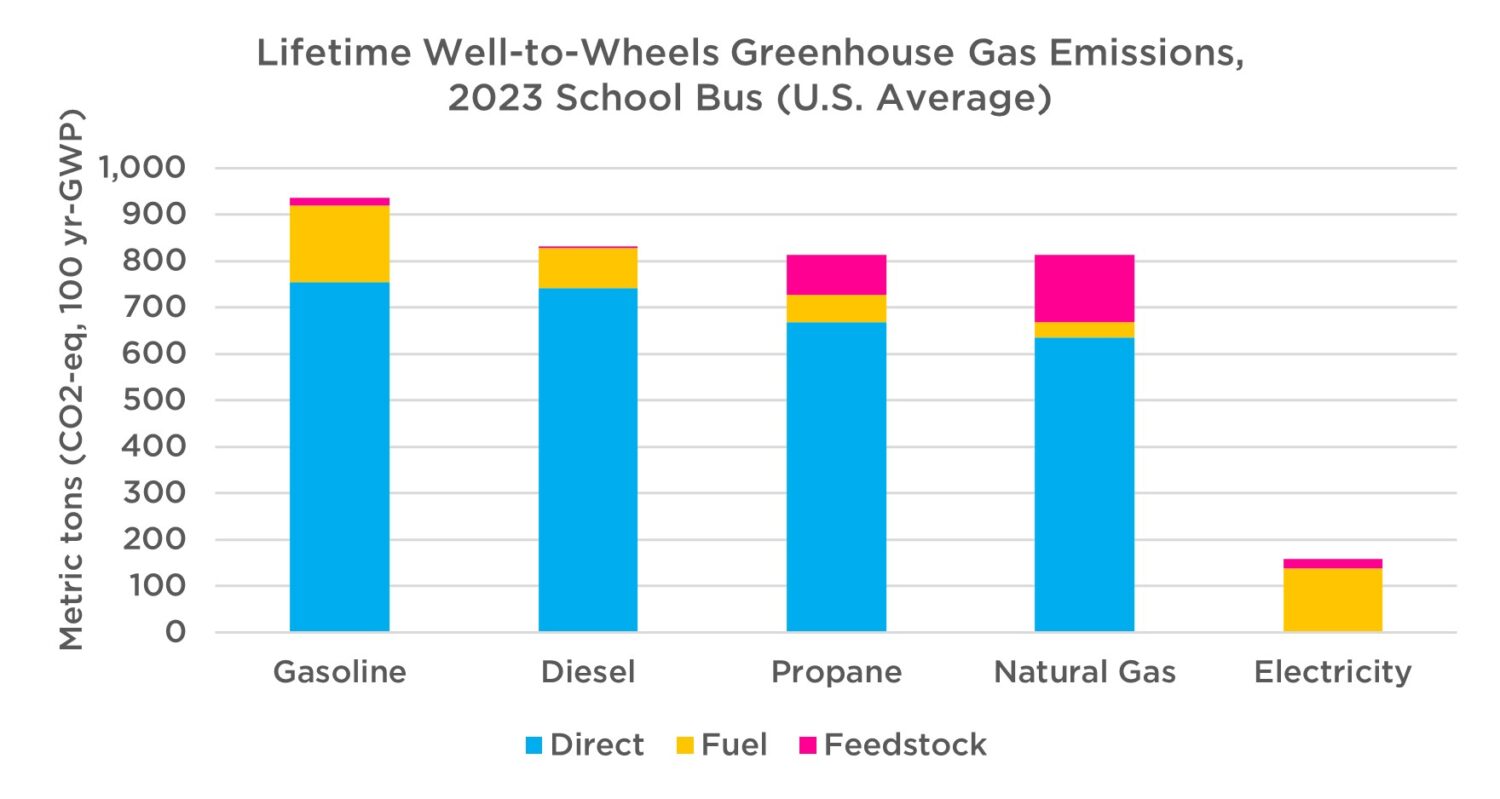
Over its lifetime, a gasoline, diesel, propane or natural gas school bus will be responsible for more than 800 metric tons of global warming pollution. An electric school bus on the other hand drastically reduces climate pollution by well over 80 percent. As the electricity grid continues to evolve with more solar and wind power displacing coal and natural gas, an EV school bus purchased today will get even cleaner over its lifetime.
But lower climate emissions aren’t the only benefit. Reductions in pollutants including particulate matter, nitrogen oxides, carbon monoxide and others, help to clean the air – not just for children riding the bus, but everyone in the communities where these buses travel, as well as near the refineries where fuels are produced.
To compare air quality impact of different school bus types, the tailpipe and upstream pollution over the lifetime of operating a school was converted to a monetary value of the associated health impacts. School buses that contribute fewer air pollutants over their lifetime mean less exposure to dirty air, reduced risk of disease and hospital visits, and lower overall health costs associated with bus pollution. The figure below shows the results.
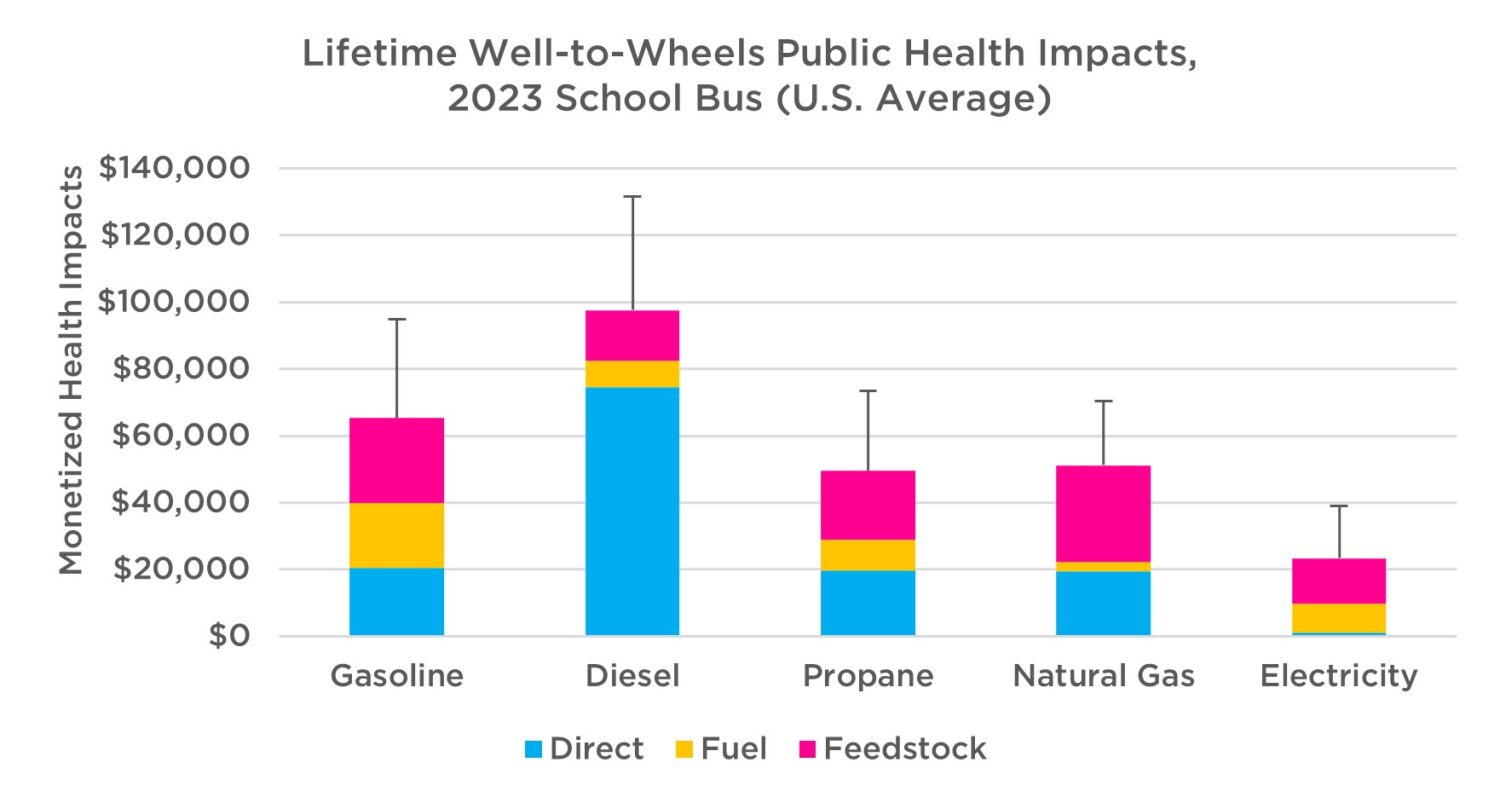
Note: A low and high health cost estimate are shown for each fuel type.
Once again, the results are clear. Electric school buses are the best choice for reducing emissions that pollute our air and harm our health. On average, an electric school bus is at least 50 percent cleaner than even the cleanest combustion alternatives, even when accounting for air pollution related to producing electricity.
Propane: best for the BBQ, not for school buses
While the vast majority of Clean School Bus Program grants and rebates are for electric buses, propane buses are eligible for, and have received some CSB Program funding. So, it’s worth looking more closely at how these two types of buses compare, especially as applicants pursue future funding opportunities, EPA makes additional awards, and Congress considers what is next for this program.
In the charts above, it’s clear that electric school buses are cleaner than propane based on the average mix of electricity sources (coal, solar, wind, hydro, natural gas, etc.) in the US. But the sources of electricity generation are different in different parts of the country. Some regions are more reliant on coal or natural gas, while others have higher production of renewable electricity like wind and solar.
So how do electric and propane school buses compare where you live? The following maps show that electric school buses are cleaner than propane school buses no matter if you live in Boise or Boston. The blue map shows the percent reduction in lifetime climate pollution of electric buses compared to propane while the green map shows the reduction in lifetime air pollution-related health costs. In both cases, the zero tailpipe emissions of electric buses and the declining emissions from our electricity grid show that going electric is the best choice.
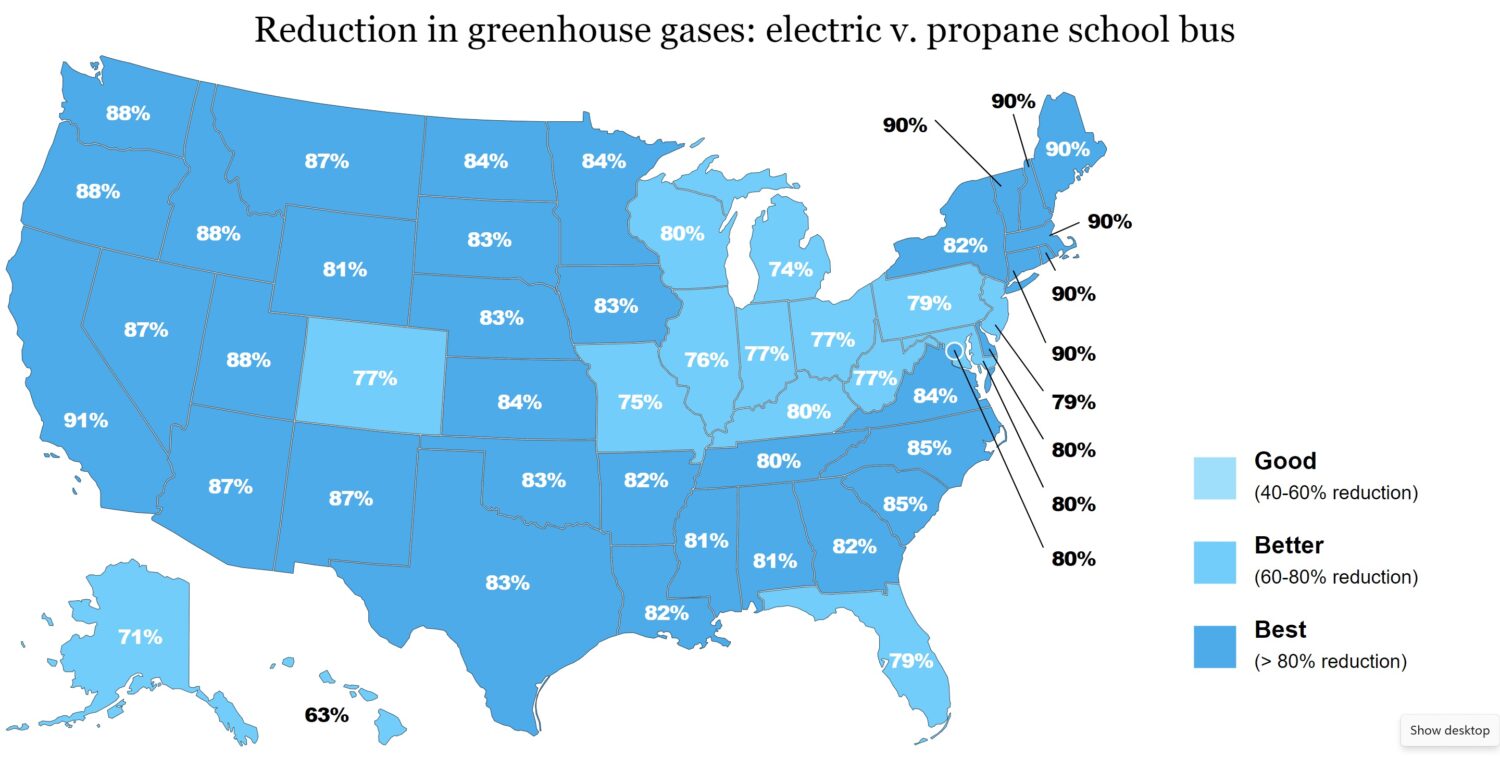
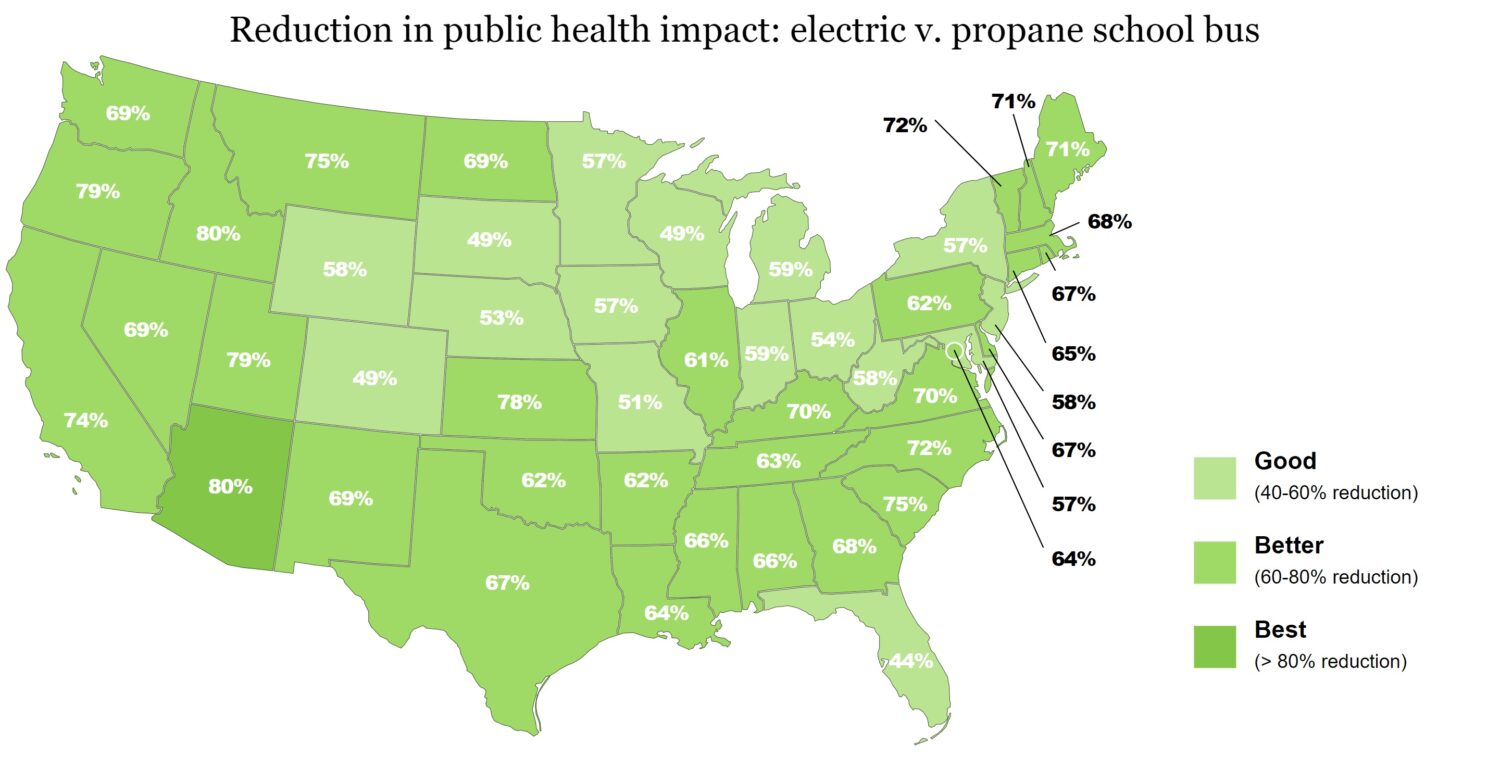
Note: Percentages represent the reduction in greenhouse gases and public health impact of an electric school bus compared to equivalent propane school bus. Public health related data for AK and HI were unavailable.
With about 500,000 school buses taking our children to and from school nationwide, we still have a ways to go to transition away from combustion technologies like diesel toward electric school buses. But the Clean School Bus Program is already helping deploy thousands of electric buses in school districts across the country – reducing pollution and cleaning the air for our kids and our communities.
Download the methodology detailing the assumptions and methods for estimating the climate and public health impacts.
